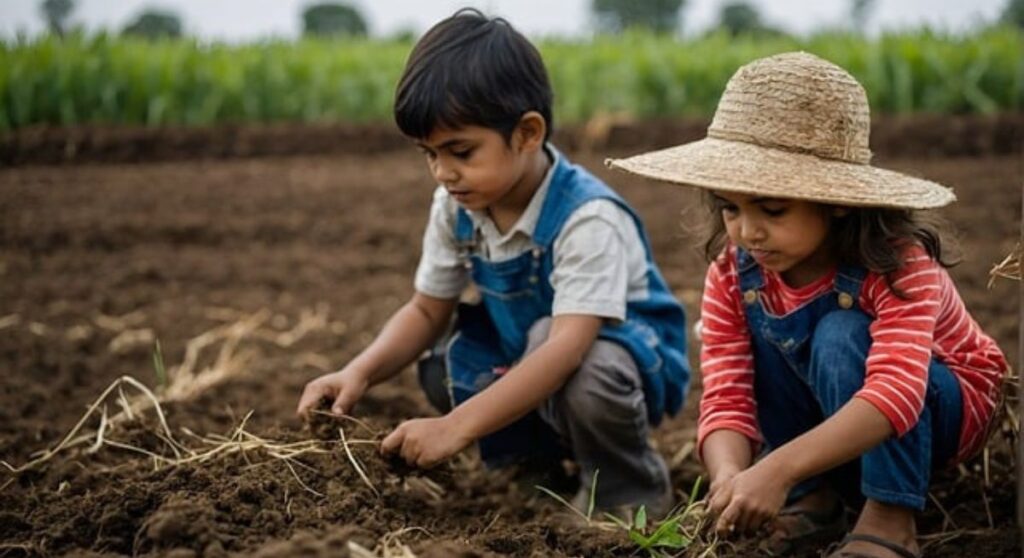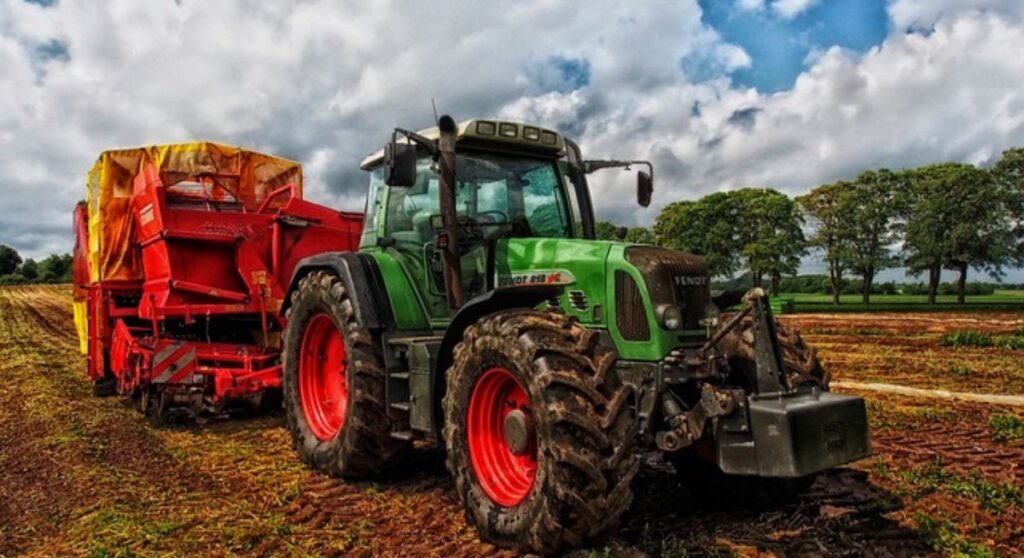Introduction:-
9 Regenerative Farming Practices That Promote Eco-Friendly Agriculture

Regenerative agriculture goes beyond being a mere trend in sustainable farming; it represents a comprehensive strategy focused on revitalizing and enhancing the health of our planet. By improving soil quality, sequestering carbon dioxide, and fostering biodiversity, regenerative farming methods cultivate an environmentally friendly agricultural system that benefits both the ecosystem and farmers alike. Here are nine essential regenerative farming practices that pave the way for a more sustainable and eco-conscious future.
9 Regenerative Farming Practices That Promote Eco-Friendly Agriculture
- Cover Cropping
Cover cropping involves farmers cultivating specific plants, like clover or rye, during off-seasons when the soil would typically be bare. These crops play a vital role in preventing erosion, enhancing soil structure, and boosting organic matter. Additionally, they foster biodiversity, improve soil fertility, and lessen the reliance on synthetic fertilizers. - Crop Rotation
Crop rotation is a time-honored practice that consists of alternating various crops in the same area throughout different seasons. This method helps to prevent the depletion of certain nutrients and gradually enhances soil fertility. By diversifying crops, farmers can naturally manage pests and diseases, thereby decreasing the need for chemical pesticides and herbicides. - No-Till Farming
No-till farming is a method that avoids soil disturbance by forgoing plowing or tilling. This approach helps maintain soil structure, minimizes erosion, and improves water retention. Moreover, no-till farming contributes to reduced carbon emissions as the soil retains carbon rather than releasing it into the atmosphere. - Agroforestry
Agroforestry incorporates trees and shrubs into agricultural landscapes, promoting biodiversity and fostering a more resilient ecosystem. Trees contribute to carbon sequestration, help combat soil erosion, and provide habitats for wildlife. They also improve water quality by minimizing runoff and can act as windbreaks to protect crops from severe weather. - Composting
Composting is the process of recycling organic waste, including crop residues and livestock manure, to produce nutrient-rich compost. This practice decreases the necessity for synthetic fertilizers, enriches soil fertility, and supports robust crop growth. Furthermore, composting helps reduce methane emissions from landfills, significantly lowering the farm’s carbon footprint. - Rotational Grazing
Rotational grazing is a livestock management strategy where animals are moved between different pasture areas. This technique prevents overgrazing, allowing grasslands to rejuvenate, which in turn improves soil health and promotes biodiversity. By mimicking natural grazing behaviors, rotational grazing enhances carbon sequestration and mitigates the environmental impact of livestock farming. - Silvopasture
Silvopasture merges forestry with livestock grazing on the same land, fostering biodiversity through a balance of trees, forage crops, and animals. This system reduces methane emissions from livestock while improving carbon sequestration, making it a highly effective regenerative practice. - Perennial Crops
Perennial crops, such as fruit and nut trees or perennial grasses, feature deep root systems that help prevent soil erosion, enhance water infiltration, and store carbon in the soil. Unlike annual crops that require replanting each season, perennial crops grow year after year, reducing soil disturbance and promoting ecosystem stability. - Water Management
Sustainable water management practices, such as rainwater harvesting, drip irrigation, and utilizing swales (shallow trenches), assist farmers in conserving water and minimizing runoff. Efficient water usage not only preserves this valuable resource but also curbs soil erosion and diminishes the environmental impact of agricultural activities.
The Benefits of Regenerative Agriculture
By adopting these regenerative farming practices, farmers can foster a more sustainable and environmentally friendly agricultural system. Here are some of the main advantages:
- Carbon Sequestration:
- Techniques such as no-till farming, cover cropping, and agroforestry effectively capture carbon dioxide from the atmosphere and store it in the soil.
- Enhanced Soil Health:
- Regenerative farming improves soil structure, boosts organic matter, and encourages biodiversity, resulting in more fertile and productive land.
- Biodiversity:
- Diverse farming practices create habitats for various plants, insects, and animals, contributing to a well-balanced ecosystem.
- Reduced Chemical Use:
- By utilizing natural pest control and enhancing soil fertility, there’s a decreased reliance on synthetic fertilizers and pesticides, thereby reducing environmental pollution.
What varieties of crops are grown in regenerative agriculture?
Regenerative agriculture emphasizes practices aimed at revitalizing soil health, boosting biodiversity, and strengthening ecosystem resilience. The crops cultivated in regenerative systems are varied and can differ based on the region, climate, and specific objectives of the farm. Here are some commonly grown crops:

1. Cover Crops
- Legumes: Peas, clover, beans, alfalfa
- Grasses: Rye, barley, oats, wheat
- Other species: Buckwheat, radishes, mustard
- Cover crops are often planted between harvests to fix nitrogen, protect the soil, reduce erosion, and add organic matter.
2. Cash Crops
Farmers practicing regenerative agriculture often grow a variety of staple and specialty crops in rotation or polycultures, such as:
- Cereals/Grains: Wheat, barley, oats, maize (corn)
- Pulses/Legumes: Beans, lentils, chickpeas, soybeans
- Vegetables: Carrots, spinach, kale, tomatoes, onions, potatoes
- Fruits: Apples, berries, grapes, melons, citrus
- Oilseeds: Sunflower, flax, canola
3. Perennial Crops
Perennials help build long-term soil fertility and biodiversity without needing to be replanted each year.
- Fruit trees: Apples, pears, peaches
- Nut trees: Almonds, walnuts, chestnuts
- Perennial vegetables: Asparagus, artichokes, rhubarb
- Perennial grains: Kernza (intermediate wheatgrass)
4. Agroforestry and Silvopasture
These systems integrate crops with trees and/or livestock. Some examples include:
- Timber trees: Pine, oak, chestnut (for timber and nuts)
- Shrubs: Hazelnuts, berries
- Pasture crops: Grasses and legumes for grazing animals, often part of a rotational grazing system.
5. Specialty and Medicinal Crops
- Herbs: Basil, oregano, mint, chamomile
- Medicinal plants: Lavender, echinacea, turmeric
Principles Guiding Crop Choices
- Diversity: Crop rotation and polycultures to enhance biodiversity and soil health.
- Perennials: Encourage perennial crops and deep-rooted plants that enhance soil stability.
- Integration: Combine crops with livestock (silvopasture) and trees (agroforestry) to build resilient systems.
Is regenerative agriculture profitable for farmers?
Yes, regenerative agriculture can be profitable for farmers, but the profitability depends on various factors, including farm management, market access, and the time it takes for regenerative practices to take effect. While the initial transition may involve challenges, many farmers experience long-term benefits and increased profitability due to several factors:

1. Reduced Input Costs
- Lower reliance on synthetic fertilizers and pesticides: Regenerative agriculture practices, such as crop rotation, cover cropping, and composting, build soil health naturally. This reduces the need for expensive chemical inputs.
- Improved water retention: Healthier soils retain more moisture, reducing the need for irrigation and decreasing water costs.
- Less tillage: No-till or low-till practices reduce labor and fuel costs associated with frequent tilling.
2. Higher Yields Over Time
- Improved soil health: As soil fertility and structure improve over time, crop yields can increase. Healthier soils can better resist drought, flooding, and pests, leading to more stable and resilient production.
- Biodiversity: Integrating livestock, perennial crops, and trees into the system can diversify income streams while improving soil health, leading to more productive land.
3. Premium Prices for Regenerative Products
- Market differentiation: Products grown using regenerative practices can often be sold at a premium, especially as consumer demand for sustainable, environmentally-friendly, and organic products grows.
- Certification programs: Emerging regenerative agriculture certifications (e.g., Regenerative Organic Certified) can help farmers market their products as higher quality and eco-friendly, allowing for premium pricing..
4. Access to Ecosystem Service Payments
- Carbon credits: Many regenerative practices sequester carbon, and some farmers are able to participate in carbon markets, where they can sell credits for the carbon they store in the soil.
- Government subsidies: In some regions, governments offer financial incentives or subsidies for farmers adopting regenerative practices, such as payments for soil conservation, biodiversity enhancement, or water management improvements.
5. Resilience to Climate Change and Economic Stability
- Less risk from crop failures: Healthy soils and diverse crop systems can help mitigate the impacts of extreme weather events like droughts and floods, reducing the financial risks of crop failure.
- Lower volatility: With diversified production (e.g., crops, livestock, and agroforestry), farmers are less reliant on a single income source, reducing the financial volatility from market fluctuations.
6. Long-Term Economic Benefits
- Increased land value: Farms practicing regenerative agriculture can see an increase in land value due to improved soil health and ecosystem services.
- Healthier ecosystems: Biodiversity and healthier ecosystems contribute to long-term sustainability and productivity, providing ongoing financial benefits to farmers over time.
Challenges to Profitability
- Transition period: The transition to regenerative agriculture can take time, and farmers may face short-term yield declines or learning curves as they adjust to new practices.
- Initial investments: Some regenerative practices may require upfront investments in equipment, training, or infrastructure (e.g., fencing for rotational grazing).
- Market access: Farmers need to find markets that value and reward regenerative practices, which may not always be available in every region.
In the long term, many farmers report increased profitability through regenerative agriculture due to the combination of reduced input costs, diversified income streams, and improved ecosystem health. However, profitability will vary depending on the farm’s location, type, and ability to access premium markets or financial incentives.
Conclusion
Regenerative agriculture is essential for fostering an eco-friendly and sustainable future in farming. By implementing these nine practices, farmers can enhance the health of their land, lower their carbon emissions, and play a vital role in combating climate change. Not only does regenerative farming benefit the environment, but it also results in more resilient and profitable agricultural systems.
References
- Rodale Institute – Regenerative Agriculture Definition and Practices
- Carbon Cycle Institute – The Role of Carbon in Regenerative Agriculture
- Regeneration International – Key Principles of Regenerative Agriculture
- USDA – Sustainable Agriculture Practices and Resources

